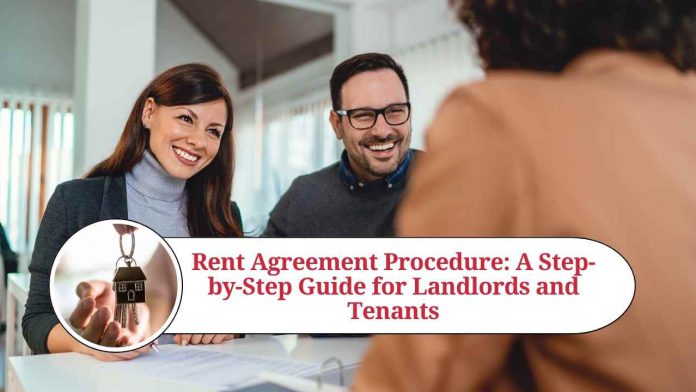Rent Agreement Procedure: A Step-by-Step Guide
If you’re planning to rent out your property, it’s crucial to have a well-drafted rent agreement in place. A rent agreement, also known as a lease agreement, outlines the terms and conditions of the tenancy and serves as a legally binding contract between the landlord and the tenant. In this blog, we’ll walk you through the procedure of creating a rent agreement, step-by-step.
Step 1: Determine the Terms and Conditions of the Tenancy
Before creating a rent agreement, you need to determine the terms and conditions of the tenancy. This includes the rent amount, security deposit, duration of the tenancy, and any other clauses that you want to include in the agreement.
Step 2: Prepare the Rent Agreement
Once you’ve determined the terms and conditions, it’s time to prepare the rent agreement. You can either draft the agreement yourself or seek the help of a legal expert to ensure that the agreement is legally sound. Make sure that the agreement includes all the necessary details, such as the names of the landlord and the tenant, the property address, and the terms and conditions of the tenancy.
Step 3: Get the Agreement Stamped
After preparing the rent agreement, you need to get it stamped. The stamp duty varies from state to state, so make sure to check the stamp duty rates in your state. Once you’ve paid the stamp duty, the agreement needs to be registered with the sub-registrar’s office.
Step 4: Sign the Agreement
Once the agreement is stamped and registered, both the landlord and the tenant need to sign the agreement in the presence of two witnesses. Make sure to keep a copy of the agreement for your records.
Step 5: Provide a Copy of the Agreement to the Tenant
After both parties have signed the agreement, make sure to provide a copy of the agreement to the tenant. This will serve as a proof of the tenancy and will also help avoid any disputes in the future.
Here are some additional details and tips to keep in mind when going through the rent agreement procedure:
- Include all relevant clauses: In addition to the basic terms and conditions of the tenancy, consider including clauses related to maintenance responsibilities, restrictions on subletting, and termination procedures.
- Use clear and concise language: Avoid using overly technical language or legal jargon that the tenant may not understand. Instead, use clear and concise language to ensure that both parties understand their rights and obligations.
- Consult with a legal expert: If you’re not confident about drafting the rent agreement yourself, consider consulting with a legal expert to ensure that the agreement is legally sound and enforceable.
- Verify tenant details: Before drafting the agreement, make sure to verify the identity and other relevant details of the tenant, such as their employment status and previous rental history.
- Keep multiple copies: Make sure to keep multiple copies of the agreement in a safe place, such as a digital storage platform or a physical safe.
- Review and update periodically: Review the agreement periodically and update it if necessary, such as if there are changes in the terms and conditions of the tenancy or if there are changes in the applicable laws.
By following these tips and the step-by-step procedure outlined in this blog, you can ensure that your rent agreement is comprehensive, legally sound, and protects your interests as a landlord.
Read more useful content:
Frequently Asked Questions (FAQs)
What is a rent agreement?
A rent agreement is a legally binding contract between a landlord and a tenant that outlines the terms and conditions of the tenancy, including rent amount, security deposit, duration of the tenancy, and other relevant clauses.
Is a rent agreement mandatory?
While it is not mandatory to have a rent agreement in some jurisdictions, it is strongly recommended to have one in place to protect the interests of both parties and avoid any disputes.
How long does a rent agreement last?
The duration of a rent agreement depends on the agreement between the landlord and the tenant. Typically, a rent agreement lasts for a fixed term, such as 11 months or 1 year, and can be renewed at the end of the term if both parties agree.
Can the terms of the rent agreement be changed during the tenancy?
The terms of the rent agreement cannot be changed during the tenancy without the agreement of both parties. However, if both parties agree to the changes, the rent agreement can be modified through an addendum or an amendment.
What is a security deposit?
A security deposit is a sum of money paid by the tenant to the landlord at the beginning of the tenancy to cover any damages or unpaid rent at the end of the tenancy.
Can a landlord deduct from the security deposit for normal wear and tear?
No, a landlord cannot deduct from the security deposit for normal wear and tear. However, if there are damages beyond normal wear and tear, the landlord can deduct from the security deposit to cover the costs of repairs or replacements.
Can a tenant sublet the property?
Whether a tenant can sublet the property or not depends on the terms of the rent agreement. Some rent agreements prohibit subletting, while others allow it with the agreement of the landlord.
What happens if a tenant breaks the terms of the rent agreement?
If a tenant breaks the terms of the rent agreement, the landlord may be able to terminate the tenancy and evict the tenant. However, this depends on the nature and severity of the breach and the applicable laws in the jurisdiction.
What is a notice period?
A notice period is the period of time required by the landlord or the tenant to provide notice before terminating the tenancy. The notice period is usually specified in the rent agreement and varies depending on the jurisdiction.
What should I do if I have a dispute with my landlord or tenant?
If you have a dispute with your landlord or tenant, try to resolve the issue through communication and negotiation. If this does not work, consider seeking legal advice or mediation to resolve the dispute.




















